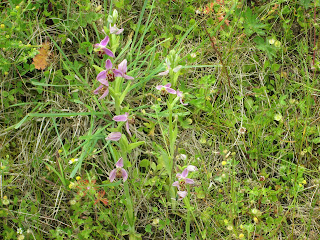he Martinstown Rook population seems to have been
severely reduced in recent weeks. The eight nests in he Horse Chestnut
tree outside my bedroom window which were such a hive of activity
earlier in the year are now unused, as also are some others in the
village.
The rooks were always the first to visit my bird table in the morning, taking their fill before the Jackdaws,
next in the pecking order, arrived, but have not been seen for three
weeks.. There has also been some anomalous behaviour in the Rooks' night
roost as a large number have, on occasions, gathered in Martinstown
rather than in the woods near Bradford Peveral where they usually spend
the night. It seems likely that there has been some culling, perhaps as a
result of recent government changes in the permit system for shooting
pest species.I can understand why Rooks, Carrion Crows and Wood Pigeons
are on the list as pest species but Why, Oh Why, do Moorhens figure
there?
I have sponsored one of this year's brood of Cuckoos.
named Nussey. Born and reared by unwitting foster parents in the New
Forest, it has been fitted with a transponder which will enable
satellite tracking as it makes its way to the African rainforest where
it will overwinter.
It is now in central France putting on a bit of fat to provide the energy for its long flight.
Sunday, 30 June 2019
Wednesday, 12 June 2019
Weymouth Relief Road Walk.
A walk today down the bridleway alongside the Weymouth Relief Road currently covered in Oxeye Daisy and Kidney Vetch ,and towards the bottom of the slope, a magnificent display of Bee Orchids.
The first Bee Orchids to arrive here were two that were seen a couple of years ago and they have now increased in number to 198.
Bee Orchid Click to enlarge
Among the Bee Orchids there was a single Pyramidal Orchid. The rather cold, unseasonal weather meant that there were few butterflies in evidence, two Small Blue and two Adonis Blue were seen, and one day flying moth, a Burnet Companion
 | |||
| Weymouth Relief Road bridleway Click to enlarge. |
Bee Orchid Click to enlarge
Tuesday, 4 June 2019
Privet Hawk Moth.
Privet Hawk Moth Photo. John Elliott
The first of the Hawk Moths to come to my UV light trap this year, the Privet Hawk Moth has
a 10 cm. wing span, slightly more than that of a House Sparrow. It normally perches with the upper wings closed showing only the rather drab browny patches, but when preparing for flight it reveals a bright pattern of pink and black stripes on the underwing. Other species regularly caught at the moment include Hebrew Character, Treble Lines, White Ermine, Muslin Moth, Buff Tip, Dark Arches, Heart and Dart, and, a first for Martinstown, a Streamer.
The first of the Hawk Moths to come to my UV light trap this year, the Privet Hawk Moth has
a 10 cm. wing span, slightly more than that of a House Sparrow. It normally perches with the upper wings closed showing only the rather drab browny patches, but when preparing for flight it reveals a bright pattern of pink and black stripes on the underwing. Other species regularly caught at the moment include Hebrew Character, Treble Lines, White Ermine, Muslin Moth, Buff Tip, Dark Arches, Heart and Dart, and, a first for Martinstown, a Streamer.
Subscribe to:
Posts (Atom)

